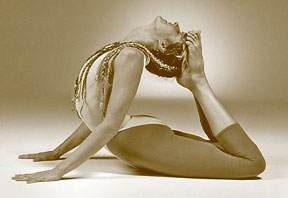|
|
|
TriYoga: Art and Science of Yogaflow®
by Kali Ray • Malibu, CA
Our true nature is sat cit ananda (existence, knowledge and bliss). This triple principle is inherent in all creation. TriYoga sadhana supports one in becoming more in tune with this harmonious flow.
The essence of sadhana (or practice), is to surrender to the universal flow. Whatever means or methods one uses, the universal life-energy, prana, requires the freedom to flow. Only through the flow does it have the power to cleanse, maintain and transform the practitioner.
Ancient yogis focused on the universal trinity by using Sri Cakra, consisting of a central triangle surrounded by 42 triangles, as their yantra (divine symbol). The triangle in the center of the yantra represents the Universal Trinity of sat cit ananda. The original deity associated with this yantra was trimurti, with three forms: Brahma, the creator; Visnu, the sustainer, and Siva the transformer. The feminine expression is Sarasvati (knowledge); Lakshmi, (bliss); and Kali (purification). The different forms of the trinity were called by various names, but all were a reflection of the universal trinity.
In the same way, hatha yoga is based on the trinity of asana, pranayama and mudra. To awaken the energy through this form of yoga, this trinity needs to flow as one.
Asana: The spine has four curves. The lumbar and cervical spine curve inward (lordosis), and the sacrum and thoracic spine curve outward (kyphosis). In addition to this natural alignment when the back appears “straight”, the spine has four primary directional movements: flexion (forward bend), extension (backward bend), rotation (twist), and lateral flexion (side-bending). To maintain the flow from one posture to another, the spine moves from one of these four directional movements or remains in the core alignment.
When flowing between a backward bend and a forward bend, the spine rolls vertebra by vertebra, either ascending or descending, while following the natural wave of the spine. To maintain the flow, a backward bend (extension) is entered through a forward bend (flexion) and a forward bend is entered through a
backward bend. An example is the two movements of Cat Pose. In Cat Pose the spine is in a gentle extension. While exhaling, one begins at the base of spine, rolling vertebra by vertebra into a flexion or tucked position. To return to Cat, one begins at the base of spine, flowing from the spinal flexion, vertebra by vertebra, back into the gentle backward bend.
In addition to the spinal wave, the whole body flows. To sustain the flow, one maintains relaxation-in-action and common alignments between the two postures. One connects, flows and dissolves each posture into the next, moving only what needs to move in order to conserve energy. To give the feeling of equilibrium, or to feel the flow of energy, one extends equally in four directions: north, south, east,
and west.
Precise alignments support the natural alignment of the skeletal and muscular systems. With this strong foundation, the body relaxes in the flow. When one enters the flow, prana increases, awakening the inner flow.
Pranayama: One maintains a rhythmic svara (breath flow). As the air flows, the body relaxes and the mind calms. The body and breath are synchronized so the movement has an even graceful, rhythmic tempo. The flow of air is the same throughout puraka (inhalation) and recaka (exhalation), neither speeded up nor slowed down.
One allows the length of the breath to extend, as stretching the breath increases the life energy allowing fewer breaths per minute. Yogis claim that decreasing the number of breaths per minute increases the life span. Animals that breathe more breaths per minute have a shorter life span; those that take fewer breaths per minute live longer.
With flowing postures, the breath ratio used is one-to-one, inhale to exhale. During sustained postures the breath ratio is one-to-two. This flow of one-to-two corresponds to the heartbeat activity-to-rest ratio. Inhalation is the active phase of respiration and exhalation corresponds to rest. Before establishing these ratios, one first makes the breath smooth, without interruptions or jerks.
Mudra assists inner communication in the same way that hand gestures assist outer communication. Hasta (hand) mudras are either sustained or flow one into the next. Hasta mudras synchronized with posture and breath seal and focus the trinity energies of body, mind and spirit as well as the three gunas.
Many hasta mudras can be used with yoga practice. One example is jnana mudra where the first (thumb) and second fingertips touch. The remaining three released fingers symbolize sat cit ananda.
When the eyes are open, one uses the eye mudra of trataka, a relaxed steady gaze at one point. When eyes are closed, one uses Bhrumadhya Mudra with the eyes focused at Ajna Cakra (space between eyebrows). Ultimately these eye mudras direct the flow of energy upward.
Through the flow of yogasana, pranayama and mudra, prana becomes balanced which gives the foundation for physical, mental and spiritual accomplishments. The essence is in the flow. As the river flows into the ocean, we flow in and from the source.
Kali Ray, internationally renowned yogini and founder of TriYoga®, lives a life fully devoted to yoga. Teaching on a daily basis for over 30 years, she has presented more than 20 keynote addresses and innumerable in-depth programs worldwide. Guided by kriyavati (kundalini-inspired hatha yoga), she has systematized asana, pranayama and mudra. TriYoga is presently taught in 25 countries. Swamini Kaliji’s presence, her mastery of the flow and the ageless wisdom of TriYoga have inspired and transformed countless lives.
|

